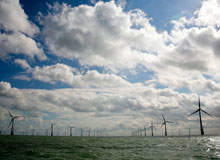
The 300MW Thanet offshore wind farm located 11km north-east off the coast of Thanet, Kent in the UK, was one of the 15 Round 2 UK offshore wind projects announced by the Crown Estates in January 2004 and the first to receive consent. Owned by Swedish energy company Vattenfall, Thanet is one of the largest operational offshore wind farms in the UK.
The project received approval from the government in December 2006; construction began in January 2008 with the final turbine being installed in June 2010. The project was completed at an estimated cost of £780m.
A test run of the wind farm was conducted in May 2010, during which up to 2.8MW of power was generated. The wind farm is designed for an operational life of 40 years and can generate enough electricity to power 240,000 homes annually.
History of Thanet Offshore Wind
Related content
London Array Offshore Wind Farm, Thames Estuary
London Array offshore wind farm located off the coasts of Kent and Essex in the outer Thames Estuary was conceived to be the world’s largest wind farm.
Warwick Energy initially conceived the idea of the offshore wind project in 2003 as part of the Round 2 offshore wind projects. Warwick received the licence for the site under an agreement with The Crown Estate and formed the project company Thanet Offshore Wind Limited (TOW). Christofferson, Robb & Co (CRC), a hedge fund firm, bought TOW in September 2007.
Warwick Energy continued to manage the construction and operation of the project until October 2008, when Vattenfal acquired CRC in the November and bought all shares of TOW. Vattenfal took over the development of the project and went ahead with the construction.
Thanet wind farm onshore facility
The wind farm is built in a water depth of 20m to 25m and is spread across an area of 35km². It consists of 100 Vestas V90 wind turbines each with a capacity of 3.0MW, installed in less than 100 days. The turbines are mounted on monopile foundations that are 500m apart along the rows and 800m apart between the columns.
The 33kV / 132kV offshore substation is equipped with two 180MVA power transformers, as well as high-voltage and medium-voltage switchgear. Thanet is the world’s first wind farm to have two power transformers.
The electricity generated at the farm is stepped up at the substation from 33kV to 132kV and transmitted to shore via two three-phased 132kV high-voltage subsea cables. Electricity enters the grid at an onshore high-voltage switching station in Richborough, Kent.
The onshore substation is equipped with a reactive-power compensation system based on static var compensator (SVC) technology. It improves the voltage quality, ensures grid code compliance and provides the required power factor correction.
A two-storey onshore maintenance facility has been built for the operation and maintenance of the wind farm. The timber roof carries photovoltaic panels fixed to ceramic slates. The solar panels heat water, thus conserving energy, and the building also features a rainwater harvesting tank.
Contractors involved with the Thanet project
Siemens was awarded a contract worth £72m to connect the Thanet offshore wind farm to the British power grid. It constructed the offshore substation platform equipped with a substation and supplied the two transformers. Siemens also built the high-voltage switching station in Richborough, Kent.
Prysmian Group supplied two high-voltage undersea cables that were manufactured at its submarine cable factory in Arco Felice. Vestas Wind Systems supplied the offshore wind turbines. Danish offshore wind farm services provider A2SEA installed the turbines using its Sea Jack vessel. Monopile foundations were supplied by Sif Group and Smulders Group.
Local building contractor WW Martin was awarded a contract worth £1m to construct the onshore maintenance building.
Renewable electricity sources and wind power in the UK
Since 2008, the UK has been the world leader in offshore wind energy, which accounts for 21% of the electricity generated from renewable sources. The nation produces 53% of its renewable electricity from wind, both onshore and offshore. In 2013, 14.9% of total electricity in the UK was generated from renewable sources, up from 11.3% in 2012.
As of this year, there are 1,075 turbines installed across UK waters that have an offshore capacity of 3,653MW. They produce 8TWh of electricity annually, enough to power approximately two million homes. A further 5.7GW of installed capacity is under construction and a further 12.3GW is in the planning stage.
In 2007, the UK Government agreed to a European Union target to generate 20% of the continent’s energy from renewable sources by 2020. As per the agreement, the UK is required to generate 15% of its energy (electricity, heat and fuel for transport) from renewable sources, which requires appproximately 7,500 offshore wind turbines by 2020.
In order to achieve these targets, the Crown Estate initiated a series of licenses to develop offshore wind power projects in the UK. Round 1 was launched in 2001 and 18 offshore wind projects were authorised to proceed. Most of the projects are currently nearing completion and have a potential capacity of 1.5GW.
The UK faced immense pressure to reduce carbon emissions in 2003, which led to the launch of Round 2. The projects in Round 2 are located in the deeper waters of Greater Wash, Greater Thames and Irish Sea, and will add 7.2GW of capacity.
Round 3 was announced in 2010 and will call for the start of construction later this year. The UK is estimated to have potential to produce 40GW of power through wind farms in shallow waters, while those in deep waters can produce up to 80GW.


